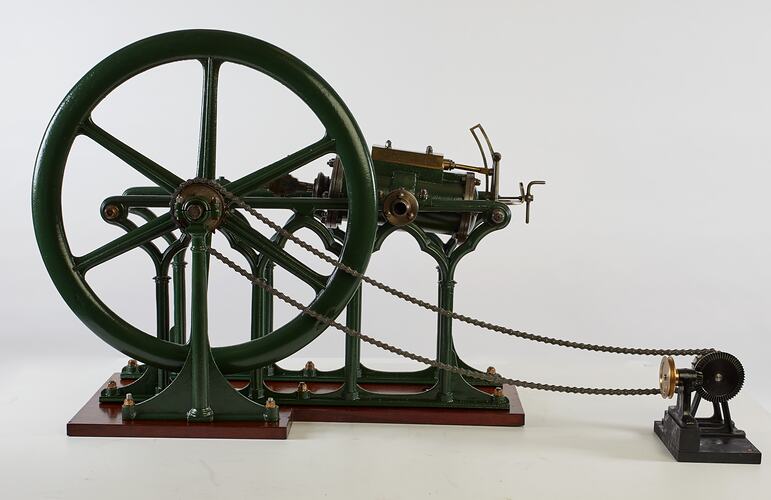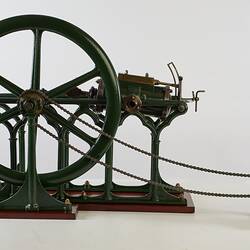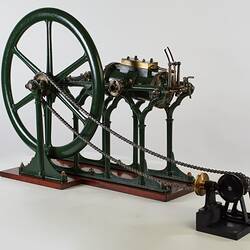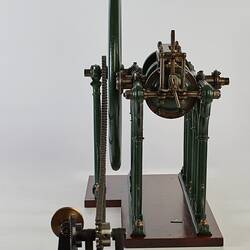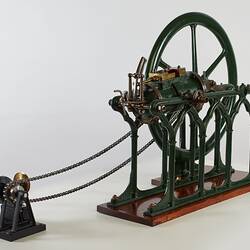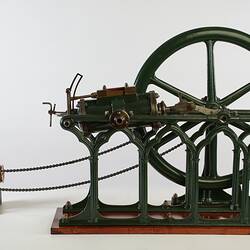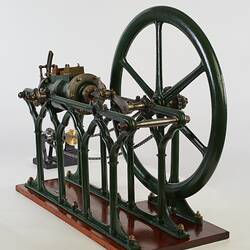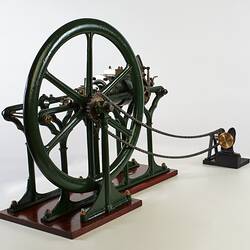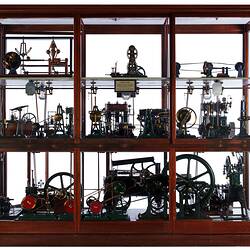Summary
Oscillating single-cylinder non-condensing steam engine, rated at approximately 1 horsepower and operating at 75 rpm.
In this unusual design, the cylinder oscillates or rocks on a central pivot as the flywheel and crankshaft rotate. Oscillating engines were often used in early paddle steamers because of their compact size and the ability for the cylinder to be mounted at any angle. This small and compact full-sized example was intended for driving small machines like a printing press or sewing machines.
This type of steam engine was first designed by the Scottish engineer, William Murdock (1754-1839). He was employed from 1777 to1830 by Boulton & Watt, steam engine manufacturers, Birmingham, England. He produced a model of this engine type in around 1784 which was subsequently copied by other manufacturers. Several other inventions relating to steam power are attributed to Murdock and he also pioneered the use of coal gas for illumination in 1792.
The engine was donated to the museum from the Estate of Mr James Alexander Smith, of 25 Collins Place, Melbourne, a prominent Melbourne engineer who began his career with the railways before establishing himself in private practice as a consulting engineer and gaining a 'world-wide reputation' for 'his research into challenging engineering problems'. He was president of the Victorian Institute of Engineers from 1908-1911 and was one of three experts appointed by the Commonwealth Government to judge the worldwide competition held seeking designs for the Federal Capital which became the city of Canberra. He also served as president on the Council of the Melbourne Working Mens' College (now RMIT University), and it was probably through this connection that he developed an interest in the Industrial & Technological Museum, a predecessor to Museums Victoria. The engine was 'sectionized' in the museum workshop in 1936, and installed as a working model in Queens Hall.
The engine was for many years incorporated in the large interactive Working Models Case at the old Swanston Street museum and in 1991, was adapted by the museum to operate with a push-button controlled electric motor drive as part of the interactive displays at Scienceworks.
Physical Description
Varnished wooden base with most of the model components of green painted metal and some bright steel parts. There are also a few lacquered copper alloy parts, some with an orange paint coating. There is a chain to drive the model. There is a small plastic label bearing the number "7" glued to the wooden base.
More Information
-
Collection Names
-
Collecting Areas
-
Acquisition Information
Donation from (Estate of) Mr James Alexander Smith, 14 Aug 1935
-
Designer
Mr William Murdock, Soho Works, Birmingham, England, Great Britain, circa 1785
Of engine. -
Classification
Mechanical engineering, Steam power, Stationary steam engines
-
Category
-
Discipline
-
Type of item
-
Overall Dimensions
800 mm (Width), 365 mm (Depth), 705 mm (Height), 63 kg (Weight)
-
References
William Murdock. 2015. Encyclopædia Britannica Online. Retrieved 03 September, 2015, from [Link 1] Report of The Trustees of The Public Library, Museums, and National Gallery of Victoria for 1936, with a Statement of Income and Expenditure for the Financial Year 1935/36, 'Industrial and Technological Museum, Report of the Curator', 1936 p. 64, "The Oscillating Cylinder Steam Engine presented in 1935 by Mr. James Alex. Smith, has been sectionized in the workshop and installed as a working model."
[Book] Churchward, Matthew. 1995. The Victorian Steam Heritage Register.
-
Keywords
Oscillating Steam Engines, Steam Engines, Model Steam Engines
